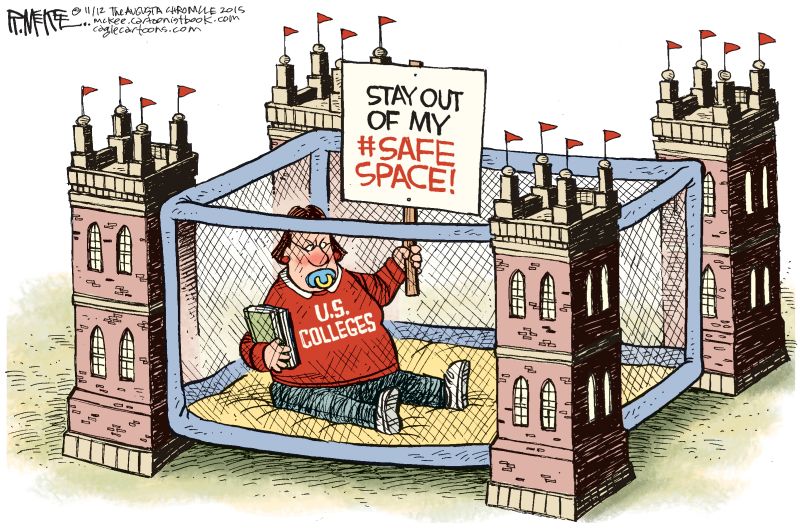By Elizabeth Harrington • Washington Free Beacon
The University of Arizona is encouraging college students to cry “ouch!” when they hear something offensive, make artwork about race relations, have story time, play four corners, and take a “time out” if they feel uncomfortable.
A new guide for faculty on “Diversity and Inclusion in the Classroom” offers tips for “inclusiveness” and how to establish a “safe space” in the classroom. The guidelines are voluntary for faculty and were first reported by the College Fix.
The guidelines offer “Strategies for Engaging Students,” which include the “One Diva, One Mic” rule and allowing 20-year-olds to yell “ouch” and “oops” in class.
“Creating a safe space for students for engaging in dialogue about challenging topics is vital in promoting positive intergroup interactions,” wrote Jesús Treviño, the author of the guide and vice provost for “inclusive excellence” at the university.
Ground rules for “personal and group affirmation” include “One Diva, One Mic,” which stipulates that college students should not interrupt each other.
The guide also suggests the “Oops/ouch” rule.
“If a student feels hurt or offended by another student’s comment, the hurt student can say ‘ouch,'” the university said. “In acknowledgment, the student who made the hurtful comment says ‘oops.'”
“Ground rules help students feel comfortable being honest,” the university said. “Students should be affirmed for being open, honest, and vulnerable about their perspectives and experiences.”
The guidebook suggests games for students like “Four Corners,” where students are split into each corner of the room based on how much they talk in class.
University faculty are encouraged to engage in storytelling so students can “learn to bond and understand each other.”
“The objective of storytelling is for students to gain a deeper understanding of the different groups to which their peers belong,” the guide states. “Stories are interesting and convey emotion, history, pain, joy, spirituality, friendship, forgiveness, and other ideas.”
In addition to telling stories, professors should have students make “collages” and “art work,” participate in “reflection sessions,” and keep a journal about their feelings.
“Collages and other forms of art tap into students’ creative and visual side,” the guide states. “Here students might be asked to create a collage depicting intergroup relations or intergroup concepts and ideas.”
Another tool is the “fish bowl discussion,” where students sit in a circle in the classroom and talk about issues like diversity.
The university guide also explains what a metaphor is to faculty.
“A metaphor [is] ‘a figure of speech in which a word or phrase literally denoting one kind of object or idea is used in place of another to suggest a likeness or analogy between them’ (Webster’s Dictionary),” the guide states.
The university encourages professors to use metaphors to explain race relations in America.
“Someone might provide the following metaphor: ‘Race relations in America remind me of the relationship between the earth and the sky. The earth represents ethnic/racial minorities, which sends water (e.g., diverse cultures, perspectives, opinions) to the clouds through the process of evaporation, making the sky look beautiful. For their part, clouds (which remind me of Whites) return the water back to the earth and enrich it. Both the earth and the clouds are equally important and need each other in order to live and make life interesting.'”
The guide is meant to serve as a resource for “difficult or challenging topics in the classroom” and is not required.
The guide includes examples of “tension” that could occur in class, including a hypothetical where a straight religious student claims that “LGBTQIA+ individuals do not have the right to exist.”
The university argues “inclusiveness matters,” saying all classroom discussions should be done in a “safe, caring, and respectful atmosphere.”
“Discourage the devaluation of emotions and feelings,” the university tells professors. “We may laugh and cry together, share pain, joy, fear and anger.”
An example of the guidelines in practice includes students and professors taking “time outs” during class.
“If you feel uncomfortable, you may need to take time out, but let the facilitator know,” the guide states.
The guidelines teach about “microinsults” and “microinvalidations” in addition to the standard “microaggressions.”
The university defines “microinsults” as “[b]ehaviors, actions, or verbal remarks that convey rudeness, insensitivity, or demean a person’s group or social identity or heritage.”
“Microinvalidations” are “[a]ctions that exclude, negate, or nullify the psychological thoughts, feelings or experiential reality of people who represent different groups.”
The university provides examples of microaggressions that faculty should avoid, like announcing a student’s name—”Jesús Quintanilla”—wrong, “assigning class projects that are heterosexist, sexist, racist, or promote other oppressions,” or using “heterosexist” language in class.
Professors also are encouraged to respect student’s preferred pronouns in order to avoid committing a microaggression.
For instance, a professor should not say, “Alex, you use ‘they/them’ pronouns. No, that’s too confusing. They is plural. I’m going to use him for you.”
Professors are told to stop “problematic behavior,” such as “microaggressions,” in the classroom immediately.
If “someone makes a joke that is racist, sexist, homophobic, etc.,” the guide recommends that professors respond, “I didn’t think this was funny. I’d like you to stop.”
Nevertheless, the guidebook states it is “okay to use humor in class.”
“However, make sure that it is appropriate humor that does not target or degrade any student in the class or group of people overall,” the university said.

